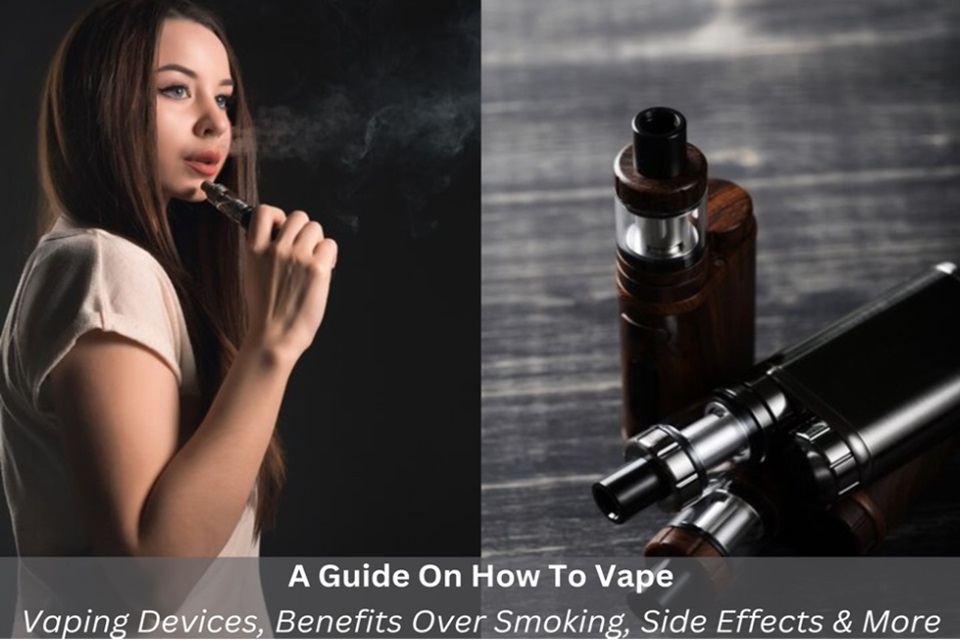A Guide On How To Vape: Vaping Devices, Benefits Over Smoking, Side Effects & More
According to a survey by the American Lung Association, over 4,80,000 people die per year just by smoking. 41,000 die per year from second-hand smoke (passive smoking: people who don’t smoke but breathe in other people’s tobacco smoke). These numbers are horrifying when the majority of people are young adults. However, vaping has emerged as an alternative that has the potential to make people quit smoking and lead a healthy life. In this article, we will show how to vape, which devices are the best to use, its benefits, and potential side effects.
What Is Vaping?
Vaping involves heating a liquid containing nicotine, flavorings, and chemicals to produce inhalable vapor. The liquid is in a device commonly known as an e-cigarette or vape pen. The liquid is turned into a vapor that is then inhaled by the user. Vaping has become a popular alternative to smoking traditional cigarettes.
Vaping Devices
- Vape Pens: These devices are slim, pen-shaped, and easy to use, which makes them beginner-friendly. They come with a battery and an e-liquid tank.
- Pod Systems: Pod systems are compact devices with disposable or refillable pods that contain e-liquid.
- MODs: Mods (Modified Vaping Devices) are larger and customizable vaping devices. They have a box-like shape and allow users to adjust settings like wattage and temperature.
- Disposable E-cigarettes: These are single-use vaping devices that are pre-filled with e-liquid. Once the e-liquid is depleted, the entire device is discarded.
- Mechanical MODs: Devices of this type are not regulated and they operate by delivering power from the battery directly to the atomizer. They are generally utilized by skilled vapers who have a good grasp of battery safety and Ohm’s law.
- All-in-One Devices: AIO devices integrate the tank and battery into one unit, making them compact and user-friendly.
- Sub-Ohm Tanks: Sub-ohm tanks are tanks with coils that have a resistance lower than 1 ohm. They’re designed to produce large vapor clouds and intense flavor.
Key Components Of Vaping Devices
- Battery: The battery is used to power the device and heat the coil to produce a vape.
- Tank Or Cartridge: It contains liquid in the form of e-liquid or vape juice, which creates vapes when heated.
- Atomizer Or Coil: This is the heating element that vaporizes the liquid. It’s usually made of metal wire that heats up when electricity passes through it.
- Mouthpiece: It is the part where you inhale from.
Types Of Chemical & Flavours
- Nicotine: Nicotine is a highly addictive substance found in tobacco, and it is also the most harmful one to lung health. Vape devices are designed in such a way that people can use them without nicotine. However, if someone desires to have nicotine, they can customize their flavor as per their preference.
- Propylene Glycol (PG): It is a common base fluid in e-liquids. It helps distribute flavor evenly and produces a throat hit similar to that of smoking.
- Vegetable Glycerin (VG): It is another base fluid used in e-liquids. It’s thicker than PG and produces denser vapor clouds.
- Flavorings: These are food-grade flavorings added to e-liquids to create different tastes and aromas. They can range from fruity flavors like strawberry and mango to dessert flavors like vanilla and chocolate.
- Optional Chemicals: Some e-liquids may contain additional chemicals, such as stabilizers, sweeteners, or additives to enhance flavor or shelf life.
Benefits
Vape doesn’t contain tar and nicotine which makes it a safer option. Thousands of people die each year due to lung cancer caused by smoking. Vaping emerged as an alternative and often people prefer it to quit smoking. It keeps the environment smoke-free and there is no chance of passive smoking. The option of adding flavors adds versatility as people can add the flavor of their choice which makes it more enjoyable.
Potential Side Effects
Vaping’s long-term effect has not been studied yet. It is advised to beginners that they prefer non-nicotine vape as nicotine may get addictive and they may turn towards heavy nicotine consumption. There are chances of facing respiratory challenges, including coughing and sneezing. It may increase the heart rate and blood pressure in some individuals. People who are allergic to Propylene Glycol, vegetable glycerine, and other flavors, should avoid vaping as it may cause serious issues.
Final Verdict
In conclusion, vaping is a safer choice in comparison to traditional smoking but it is not completely risk-free. There are chances that beginners and even experienced people may face adverse results which could create challenges related to health. However, it is a better option for the chain-smokers. If people avoid using nicotine during vape then it may be less harmful and addictive. In the end, it is based on the choice of the individual if they want to try vaping or not.
FAQs
What equipment is included in a vaping device?
A vaping device normally has a battery, tank or cartridge, coil (atomizer), and mouthpiece.
What are the types of vaping?
There are two types of vaping: mouth-to-lung, and direct-to-lung. Direct-to-lung is often used by experienced people.
What is the work of Propylene Glycol in vaping devices?
It is frequently used as a base fluid in e-liquids. Its purpose is to ensure that the flavor is spread evenly and produces a similar sensation in the throat as smoking.
Continue reading





